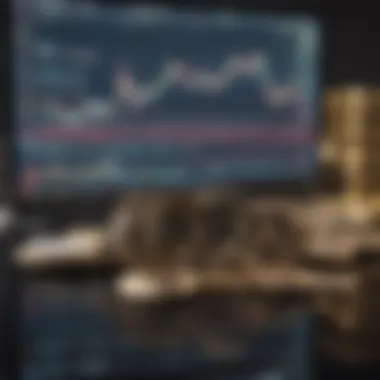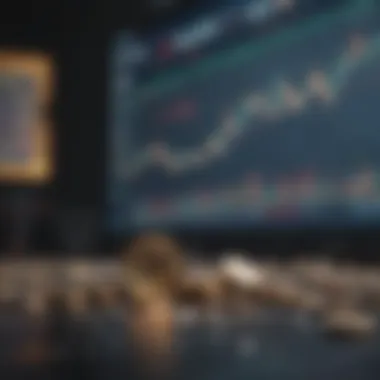Futures Trading Margin Requirements Explained


Intro
In the rapidly transforming landscape of finance, futures trading stands as a pivotal element. At its core, futures trading involves contracts to buy or sell a specific asset at a predetermined price on a set date in the future. This mechanism opens up myriad opportunities for traders, but with those opportunities come certain risks that must not be overlooked. One of the foundational aspects of participating in futures markets is understanding margin requirements.
Margins are not just numbers plastered on a trading platform—they represent the amount of capital a trader must hold to open and maintain a position. Based on leverage, margins can amplify both gains and losses, making it crucial for traders to grasp their implications fully. The concept of initial and maintenance margins shapes the framework by which traders navigate their strategies and risk management practices. Consequently, a thorough understanding of these elements helps you to make informed decisions, tailoring your approach to both risk tolerance and market conditions.
This article will delve deep into the essentials of futures trading margins. From differentiating between types of margins to understanding the potential impacts of margin calls, we will aim to equip both novice and seasoned traders with the insights necessary to traverse this intricate domain successfully. Let's unfold this topic step by step, ensuring clarity amidst the complexities of market dynamics.
Prelude to Futures Trading
Futures trading stands as a cornerstone of the financial market, providing an avenue for both speculators and hedgers to manage risk and capitalize on price movements. It's like a chess game where each move can either lead to victory or defeat, depending on how well a trader understands the intricate mechanics of the futures market.
One cannot underestimate the importance of grasping the concept of futures trading. At its heart, futures trading involves contracts that obligate parties to buy or sell an asset at a predetermined price in the future. This dynamic is crucial for price discovery and serves as a hedge against volatility. For instance, consider a farmer looking to secure a price for his grain harvest before the actual harvest date. By entering a futures contract, he locks in the price and shields himself from adverse market movements.
The benefits of understanding futures are manifold:
- Protection against price fluctuations
- Transparency in market operations
- Increased liquidity in capital markets
But what often gets overlooked is the role of margin requirements. Margin can be thought of as a necessary security deposit, ensuring that both parties fulfill their obligations in the contract. This aspect is not only pivotal for the integrity of trading but also for managing risks effectively. Each trader must appreciate how margin enhances their trading strategies and what implications arise from inadequate understanding.
In summary, delving into futures trading requires a comprehensive understanding of the terms involved, especially margin requirements. It shapes the way investors engage with the market, influencing reasoned decision-making and strategic planning. This foundational insight into futures trading prepares traders for the nuances and complexities that lie ahead, fostering both confidence and competence in the marketplace.
Understanding Margin Requirements
When you're venturing into futures trading, grasping margin requirements is essential. Not only do they dictate how much you need to deposit to trade, but they also shape your ever-changing portfolio risk. Understanding the specifics can yield an edge in decision-making while helping to manage both potential gains and losses. This section hones in on the intricacies of margin requirements, unraveling their roles in both trading strategy and financial safety nets.
What is Margin?
In the simplest terms, margin is the collateral that traders need to put up in order to establish a futures position. It's a way to ensure that there's enough skin in the game. Think of it as a financial handshake with your broker, committing to something larger than just funds you have on hand. By using margin, traders can amplify their trading capacity—allowing for exposure to greater market movements than they could afford outright.
One key point is that margin isn’t just a one-time deposit; it’s a dynamic figure that can fluctuate based on market conditions and the performance of the held positions. So, whether the market swings in your favor or against, being mindful of your margin can make or break your trading experience.
Types of Margin Requirements
Margin requirements can be broken down into three primary categories: initial margin, maintenance margin, and variation margin. Each type serves its purpose and knowing them can be a lifeguard in the turbulent waters of futures trading.
Initial Margin
The initial margin is essentially the upfront cash a trader must front to open a position. It functions as a safeguard for both the broker and the buyer, ensuring that there’s something to lose if things go south. One of its key characteristics is that it’s typically set at a percentage of the contract’s total value, which can vary depending on the asset and volatility.
This is a popular choice for newcomers because it allows them to leverage their investments without requiring the full purchase price upfront. However, the downside is that if the market takes a downturn, you could quickly find yourself in a precarious position, begging to meet future margin calls.
Benefits of Initial Margin:
- Enables leverage for larger positions.
- Lowers the immediate cash requirement for entry.
Drawbacks of Initial Margin:
- Risk of margin calls if the market shifts.
- Potential for losses to outpace initial deposit quickly.
Maintenance Margin
Once a position is initiated, the maintenance margin comes into play. This is the minimum amount that must be available in a trading account to keep the position open. Should your funds drop below this threshold, that dreaded margin call arrives, demanding more collateral or triggering position closure.
What makes maintenance margin crucial is its role in dictating how much you can tolerate in losses. That threshold is usually lower than the initial margin, which is designed to offer a buffer. For many traders, the maintenance margin is something they constantly monitor to avoid falling into a margin call situation.
Benefits of Maintenance Margin:
- Allows room for fluctuation in market valuations.
- Helps manage risk and provides a safety net.
Drawbacks of Maintenance Margin:
- Can lead to forced liquidation during high volatility.
- Requires ongoing management of account balance.


Variation Margin
Variation margin is an interesting beast, coming into play based on the day-to-day fluctuations of a position’s value. It essentially reflects the gains or losses from positions as the market evolves. If you’re closing in on a margin call, it’s this margin that gets you in the door to either add or withdraw funds.
Variation margin diminishes your margin-debt stress, but it also can amplify your financial exposure. Traders need to stay vigilant, as failing to keep enough funds in their accounts to cover this margin can lead to unsolicited trading activity—such as being forced to liquidate positions.
Benefits of Variation Margin:
- Offers daily adjustments reflecting market performance.
- Provides liquidity flexibility.
Drawbacks of Variation Margin:
- Can cause anxiety as conditions shift.
- Requires active management akin to a stock watchlist.
Understanding these types of margins provides a clearer view of how futures trading operates—it's not just about making money; it's about knowing when to step back and manage your risk effectively.
In summary, the landscape of futures trading margins isn’t just a maze of numbers; it’s an intricate dance of risk management, strategic planning, and compliance. Familiarizing oneself with these requirements offers not just knowledge, but a potentially winning strategy.
Calculating Margin Requirements
Calculating margin requirements is a cornerstone concept for anyone engaged in futures trading. It goes beyond just computing numbers; it's about understanding how these calculations impact your trading strategies and overall risk management. Proper calculation of margins can mean the difference between a successful trade and significant financial losses. In the fluid and often unpredictable world of futures trading, knowing how to calculate margins effectively empowers traders to make informed decisions, align their strategies with their risk tolerance, and navigate the complexities of the market with more confidence.
How Margin is Computed
Margin calculations can seem daunting at first glance, but they follow a fairly standard formula. Initially, the broker will stipulate an initial margin, which is the amount required to establish a position. Following that, there’s the maintenance margin, which is the minimum equity needed to keep the position open. When prices fluctuate, therefore, the total coefficient calculating these margins revolves around these pivotal factors:
- Initial Margin: This is the upfront cash or securities required to initiate a trade.
- Maintenance Margin: This represents a maintenance threshold that must not drop below a certain level to avoid liquidation of the position.
Overall, it's a relatively straightforward concept—initial margins open the gates to trading, and maintenance margins keep them from shutting unexpectedly.
Factors Influencing Margin Calculations
Margin calculations aren’t performed in a vacuum, and several factors can influence these numbers significantly. Here’s where the rubber meets the road:
Volatility
Volatility introduces an intriguing dance into the world of margin calculations. The inherent unpredictability of market prices can either make or break your trading strategy. When markets are volatile, brokers often require higher margin levels to cover the increased risk of adverse price movements. This makes it particularly important for traders to remain aware of the share's historical volatility trends. A key characteristic of volatility is its potential to fluctuate wildly in short spans of time, which can lead to bigger margin requirements. Therefore, a margin requirement that might seem manageable today could become a financial burden tomorrow, impacting liquidity. This is why understanding volatility is more than just academic; it plays a practical role affecting your wallet.
Contract Size
Contract size is another fundamental aspect of margin calculations. It defines the quantity of the underlying asset you are controlling and directly influences how much margin you'll need to set aside. Larger contracts mean larger positions, which will lead to higher margin requirements. The benefit of recognizing contract size is that it helps you gauge exactly how much capital is on the line. Contingent on market conditions, buying a larger contract can amplify profits but also expose you to higher risks. If you're considering a modest portfolio size, opting for smaller contracts might be a more beneficial strategy to avoid overwhelming your account with substantial initial margin outlay.
Underlying Asset Price
The price of the underlying asset plays a critical role as well. It impacts not just the margin requirement but also your overall exposure in the market. If you're trading assets with high price tags, the required margin will inevitably be higher, meaning you must commit more capital upfront. This poses an obvious question: are you prepared for that? Specifically, as the underlying asset's price rises or falls, the margin requirement will shift accordingly, impacting both the initial and maintenance margins necessary. One key aspect here is that successful margin management involves keeping a close eye on asset prices and adjusting your positions accordingly. Therefore, an understanding of your selected asset's price dynamics can prove invaluable as you make trading decisions.
"In futures trading, keep your eyes wide open; margins are not just numbers, they are indicators of your trading resilience."
In summary, margin calculations involve a confluence of various factors, each playing a vital role in shaping how trades are structured and managed. By grasping how volatility, contract size, and underlying asset price affect margin calculations, traders can navigate the futures market with greater astuteness.
Margin Calls and Their Implications
Margin calls serve as a critical checkpoint in the landscape of futures trading. Understanding margin calls and their implications is vital; it helps traders manage risk effectively, recognize the potential for losses, and adhere to the margin requirements established by brokers. When a trader’s account balance dips below a required threshold, the broker typically issues a margin call. This is not just a standard procedure; it acts as a warning bell. With futures trading’s inherent volatility, getting to grips with this concept can mean the difference between navigating a rough sea and going under.
What Triggers a Margin Call?
A margin call is triggered when the value of the trader's account falls below the maintenance margin level, which is the minimum equity amount a trader must hold in their account. This decline can happen for several reasons:
- Market Volatility: Sudden price swings in the futures market can quickly eat away at a trader's equity. For instance, let's say a trader holds a position in crude oil futures. If geopolitical tensions arise, prices might plummet overnight, leading to a steep drop in their account's equity.
- Leverage Usage: In futures trading, the use of high leverage can amplify both gains and losses. When traders over-leverage their positions, they expose themselves to substantial risks. If a single trade moves against them, it can trigger a margin call.
- Adverse Price Movements: Specifically, large movements in the price of a trader’s underlying asset can trigger a margin call. For example, if a trader holds a position in corn futures and a report forecasts a bumper harvest, the price may dip significantly, leading to the call.
In summary, market volatility and leverage play significant roles in triggering margin calls. Being aware of these can help traders avoid or prepare for these scenarios.
Consequences of Failing to Meet Margin Calls


Failing to respond to a margin call can bear severe consequences that may upend a trader's financial footing:
- Liquidation of Positions: The most immediate consequence is the forced liquidation of positions. Should a trader not deposit the required funds or close positions correctly, the broker has the right to liquidate the trader's positions to cover the shortfall. This potential loss can be substantial and often happens without the trader's consent.
- Reduced Buying Power: Continuing to ignore margin calls will decrease a trader's buying power over time. After experiencing a margin call, a trader’s ability to engage in further trades becomes limited, hindering their capacity to take advantage of potentially lucrative opportunities in the market.
- Long-Term Financial Impact: Unattended margin calls can create long-term financial implications, like damaging a trader's creditworthiness or reducing the leverage a broker is willing to extend in the future. This might seem like a small glitch at first, but it can lead to deeper issues down the line, potentially restricting access to necessary capital.
In short, understanding what triggers a margin call and the fallout from ignoring it is imperative for any trader engaged in futures markets. This knowledge fosters better risk management and decision-making.
Realistically, while futures trading can yield significant rewards, remaining vigilant about margin calls can protect traders from catastrophic financial consequences.
Regulatory Framework Governing Margin Requirements
In the complex landscape of futures trading, the regulatory framework governing margin requirements plays a pivotal role in ensuring market integrity and protecting participants from excessive risk. Understanding this framework is not just about grasping the rules; it’s about comprehending the underlying principles that guide trading behaviors and safeguard the financial system.
Regulations surrounding margin requirements originate from the desire to create a fair and equitable trading environment. They serve several essential purposes, such as minimizing the risk of default by participants, ensuring sufficient liquidity in the markets, and promoting transparency. By adhering to established rules, traders can better manage their positions while regulatory bodies can oversee the activities to maintain a level playing ground.
Overview of Regulatory Bodies
Regulatory bodies are the backbone of the futures trading ecosystem. They enforce the rules that govern market behavior and help maintain order. Notable bodies include the Commodity Futures Trading Commission (CFTC) in the United States, which oversees the futures and options markets, ensuring traders meet their obligations.
In addition to the CFTC, exchanges like the Chicago Mercantile Exchange (CME) and Intercontinental Exchange (ICE) set their own margin requirements based on the instruments traded and their volatility. This layered approach allows different market environments to adapt regulatory measures according to their specific needs and operational objectives.
The cooperation between these entities is crucial. They often collaborate to develop unified standards that balance market accessibility with necessary safeguards. This kind of collective oversight helps mitigate risks across the board, fostering investor confidence in futures trading.
Key Regulations Impacting Margins
Margin requirements are not just arbitrary numbers. They are sculpted by a mosaic of regulations, each addressing specific risks related to market participants. Some key regulations include the Dodd-Frank Wall Street Reform and Consumer Protection Act, which introduced stringent measures post-2008 financial crisis, emphasizing the need for sound risk management practices within derivatives markets.
Other noteworthy regulations include:
- Basel III: A global framework that addresses bank capital adequacy, stress testing, and market liquidity risk, indirectly affecting how financial institutions interact with margin requirements.
- Exchange Rules: Individual exchanges, as mentioned before, implement their own specific margin rules that cater to their market dynamics, often guided by the overall health of their trading platforms.
These regulations are designed to enhance risk management, but they also compel traders to remain vigilant regarding their margin positions. A comprehensive understanding of these rules can significantly alter a trader’s strategy and execution in the futures market.
"Margin rules are not merely bureaucratic hurdles but essential instruments that foster reliable trading practices. Ignoring them could plunge traders into unforeseen risks and losses".
In summation, the regulatory framework governing margin requirements forms an essential foundation for futures trading. By understanding the roles played by regulatory bodies and the key regulations that influence margins, traders can navigate the complexities of the market with greater assurance and strategic foresight.
Risk Management Strategies in Futures Trading
Managing risks is the bedrock of successful futures trading. Traders who ignore risk management might find themselves in a nasty bind. Futures trading can be unpredictable; thus, employing effective risk management strategies becomes a necessity, not an option. This article emphasizes why these strategies are essential and how they can influence the overall trading experience by mitigating potential losses and enhancing gains.
Utilizing Margin Wisely
Using margin wisely is a key element of risk management that can make or break a trader. It’s vital to understand how to leverage margin effectively to safeguard capital while maximizing potential profit.
Setting Appropriate Leverage
Setting appropriate leverage is not just about borrowing more money to amplify returns. It’s about finding the sweet spot that balances risk and potential reward. Too much leverage can throw you into financial distress quickly, should the market turn against you.
This concept presents a key characteristic: risk-reward ratio. By setting leverage correctly, you can align your trades with your overall risk tolerance and investment goals. It often becomes a beneficial choice for those looking to expand their portfolio without jeopardizing financial stability.
However, a unique feature of leverage is that it can lead to substantial losses as well as gains. If the market swings unfavorably, high leverage can decimate your account in a flash. Therefore, it’s wise to define parameters clearly and stick to them.
Diversification of Positions
Diversifying your positions is like not putting all your eggs in one basket. In the realm of futures trading, it’s crucial to spread your investments across various contracts or asset classes. This strategy contributes to a more stable portfolio, which tends to be less sensitive to market fluctuations.
A key characteristic here is resilience. By diversifying, you create a buffer against the inevitable volatility in any single market segment. This strategic approach often serves investors well, as it reduces the risk of total loss.
A unique feature of this strategy is its flexibility—diversify into sectors such as agriculture, energy, or even currencies to balance out potential losses in one area with gains in another. However, it’s also crucial to be mindful of not over-diversifying, as this can dilute overall returns and complicate management.
Avoiding Over-Leverage
Over-leverage is a term that should send shudders down any trader’s spine. While leveraging allows for increased exposure, it can also spiral your finances into chaos. Striking a balance between leverage and capital is fundamental to maintaining control in your trading ventures.


Understanding where to draw the line is crucial. Make it a rule of thumb to only use leverage that aligns with your trading strategy, risk appetite, and overall market understanding. Many seasoned traders advise against going beyond a leverage ratio of 2:1 for beginners, as this can mean falling into the trap of over-leverage.
In summary, effectively managing risks in futures trading demands thoughtful consideration of how to utilize margins wisely. By embracing strategies like setting appropriate leverage and diversifying positions, traders can navigate the turbulent waters of futures markets with more confidence. Moreover, avoiding over-leverage can mean the difference between thriving in the trading world or facing ruin.
The Role of Technology in Margin Management
In today’s fast-paced financial landscape, technology has carved out a crucial niche in managing margin requirements in futures trading. Traders and investors alike face multidimensional challenges due to the volatile nature of markets. But with the right tech tools, managing these complexities can become more streamlined.
Automated Margin Monitoring Tools
Automated margin monitoring tools are revolutionizing how traders manage their positions and ensure compliance with margin requirements. These tools can track account balances, margin levels, and potential margin calls in real-time, providing immediate alerts when conditions approach critical thresholds.
These tools often come equipped with features such as:
- Real-time Data Analytics: They analyze market data instantly, which enhances decision-making.
- Customized Alerts: Users can set thresholds based on personal tolerance levels, leading to proactive management of positions.
- Historical Data Usage: By referencing past price movements and margin requirements, these tools can generate insights and trends.
The significance here lies in reducing the manual workload. Traders once relied on spreadsheets and their calculations—a process that was not only time-consuming but prone to error. In a world where seconds can cost millions, automated monitoring is a potential lifesaver.
Impact of Algorithmic Trading on Margins
The rise of algorithmic trading has introduced another layer to margin management. Algorithmic trading uses computer programs to automatically place orders based on predefined criteria, often executed at lightning speed. This technology shapes margin requirements, primarily in two ways.
Firstly, algorithms can rapidly assess volatility and adjust margin levels accordingly, influencing how much capital is required for engaging in trades. When market fluctuations occur, these algorithms can apply real-time data to update margin requirements, providing liquidity and stability to trading.
Secondly, while algorithmic trading can mitigate risks, it can also exacerbate them. An unexpected market event can trigger a cascade of automated sell orders, leading to sudden price drops. Traders who are not prepared for these dynamics may find themselves facing significant margin calls.
"In an age of rapid decision-making powered by algorithms, the ability to adapt quickly to margin changes is no longer just an advantage—it's essential."
Comparative Analysis of Margin Requirements Across Markets
When it comes to futures trading, understanding margin requirements can feel like navigating a labyrinth. This section aims to shed light on the comparative analysis of margin requirements across different markets. Knowing how margin works in various contexts can be a game-changer, especially for investors and traders who want to optimize their strategies. It can help you figure out where the opportunities lie and how you can adapt your approach to different trading environments.
Futures Market vs. Stock Market Margins
When comparing margin requirements in the futures market to those in the stock market, some key distinctions arise. One notable difference is the initial margin requirement. In the futures landscape, this initial margin is usually set as a percentage of the total contract value, which can be relatively low. For example, if you are trading a contract worth $50,000, the initial margin might be around $5,000, giving you significant leverage. This leverage can enable traders to control larger amounts of capital with a fraction of the total investment.
On the other hand, stock market margins have different thresholds. Investors generally need to put down at least 50% of the purchase price to trade on margin. This means that for a $10,000 investment, you'd need at least $5,000 to start. The necessity to provide a higher percentage upfront can limit the overall leverage and maneuverability for stock traders compared to futures investors.
Moreover, in the futures markets, maintenance margins are usually lower and can vary significantly from one contract to another. In contrast, stock margins tend not to fluctuate as much, designating a more stable, albeit sometimes stringent, margin environment.
"Futures trading allows for more freedom in leverage, but it brings its own set of risks and challenges."
Another important aspect to consider is the risk management involved. Futures trading usually entails a dynamic relationship between leverage and risk. Higher leverage can amplify gains but can also lead to substantial losses if market conditions shift unfavorably. In contrast, stock traders may face a more linear risk approach, even though they, too, need to navigate the potential for margin calls.
A key takeaway from this comparison is that understanding these differences is crucial for traders who wish to deploy effective strategies in either market. Each has its pros and cons, and a seasoned trader knows the value of flexibility in adjusting their approach based on these requirements.
Global Differences in Margin Regulations
The distinction in margin requirements doesn't stop at national borders; it extends to global markets as well. Each country has its own regulatory bodies dictating specific margin requirements, and while the concepts may be similar, the implementation often varies. For instance, markets like the United States and the European Union have differing regulatory frameworks that impact how and why margins are established.
In the U.S., the Commodity Futures Trading Commission (CFTC) sets forth guidelines for futures trading margins. This ensures a level of regulatory consistency. Conversely, in the EU, regulations are shaped by various market authorities, leading to potentially contrasting rules in member states. Some markets might demand higher margins due to perceived risks involved, while others might allow for lower thresholds to stimulate market participation.
Regions like Asia are witnessing Rapid Market Growth, where countries such as Singapore and Hong Kong are becoming crucial players in the global trading game. Here, margin requirements can differ markedly from Western counterparts, influenced by local economic conditions and trading habits.
Another layer to this complexity is how fluctuations in market volatility shape margin requirements across the globe. For instance, during periods of high volatility, regulators may raise margin requirements as a precautionary measure to curb excessive risk-taking.
In summary, a comparative analysis of margin requirements across various markets illustrates how traders must be adaptable. Each market has unique characteristics that require tailored strategies, thorough understanding, and proactive management to navigate successfully. This underscores the need for continuous education and agility in your trading approach.
Finale
In the complex realm of futures trading, the concept of margin is not merely a financial detail; it represents the very foundation of trading strategy and risk management. Understanding the nuances of margin requirements is essential for both budding investors and seasoned traders alike. Through a robust comprehension of initial margins, maintenance margins, and varied regulatory requirements, traders can better position themselves to navigate this fluctuating financial landscape.
Recap of Key Points
- Definition of Margins: Margins act as a security deposit, ensuring that traders can cover potential losses. This mechanism not just buffers the participants but also maintains the market’s integrity.
- Types of Margin: Initial margin sets the stage for opening a position, while maintenance margin ensures ongoing capability to sustain that position. Variation margin, on the other hand, accounts for margin adjustments based on market fluctuations.
- Implications of Margin Calls: A margin call can strike without notice, necessitating immediate action from traders to either deposit additional funds or liquidate positions, highlighting the need for constant vigilance and proactive management.
- Technological Advancement: Tools for automated margin monitoring are revolutionizing how traders manage their futures trading. With algorithmic trading impacting margins significantly, being tech-savvy could be a game changer.
Final Thoughts on Futures Trading Margins
Navigating futures trading margins demands not just knowledge but also a strategic mindset. As we've explored, understanding the intricacies of margin requirements allows traders to make informed decisions that align with their financial goals. Balancing risk and leveraging opportunities is what distinguishes successful futures traders from the rest. The takeaway from this conversation isn't just about numbers on a sheet, but about cultivating a mindset that embraces both the complexities and the opportunities that futures trading margins present.
The path ahead for futures traders is intertwined with technology, strategy, and a strong grasp of margins. The reflective approach taken during trading decisions—understanding every aspect of margin requirements—not only fosters sound investment principles but also cultivates a more durable trading career. Traders are urged to revisit these concepts regularly, ensuring that as they grow and adapt, they do not lose sight of the critical importance that margins hold within the broader context of futures trading.



